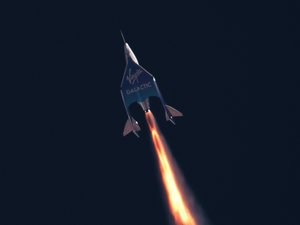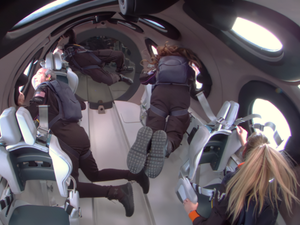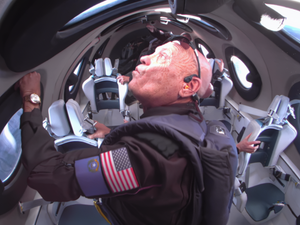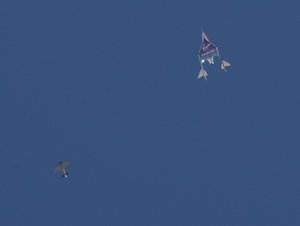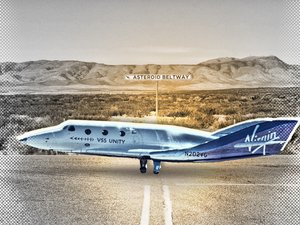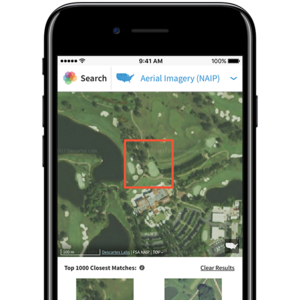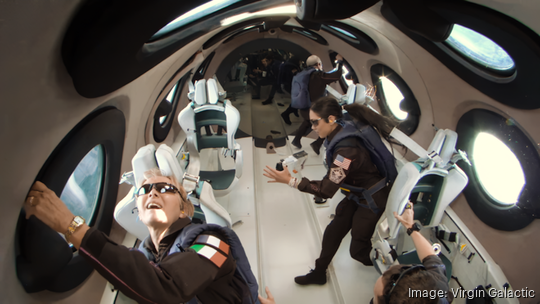
Virgin Galactic flew its second research mission of the year out of New Mexico's Spaceport America Thursday morning, marking the space tourism company's sixth New Mexico spaceflight in as many months.
Two researchers — Alan Stern, Ph.D. and Kelli Gerardi — and one private astronaut, Ketty Maisonrouge, were on board Virgin Galactic's (NYSE: SPCE) spaceship VSS Unity as it reached a maximum height of 54.2 miles above the Earth. The ship, attached to Virgin's mothership VMS Eve, took off from the Spaceport at 9 a.m. and landed back on New Mexico soil by itself just before 10 a.m.
The pair of researchers conducted suborbital experiments while in microgravity conditions for several minutes. Specifically, Stern flew with two human-tended experiments, including a biomedical harness, while Gerardi flew with three payloads — two to evaluate health care technologies in microgravity conditions and another to examine how fluid behaves in microgravity.
As well, Stern conducted practice routines in preparation for a future suborbital research flight as part of NASA's Flight Opportunities, a program designed to give scientists the opportunity to demonstrate technologies for space applications.
His research on board VSS Unity was sponsored by the Southwest Research Institute, a nonprofit based in San Antonio, while Gerardi's was sponsored by the International Institute for Astronautical Sciences. Her experiments had been developed through the National Research Council of Canada, as well.
"The suborbital science potential for Institutes like ours is unprecedented and I'm also struck by the broader societal impact of commercial human spaceflight — after today's mission, Virgin Galactic is now responsible for producing 10% of the world's female astronauts, and I look forward to seeing that number soar for my daughter's generation," Gerardi said in a statement after the flight.
Thursday's mission, dubbed "Galactic 05," was the sixth time Virgin Galactic has flown while carrying microgravity and space-based research, and the second time this year. The first came back in late June when a crew of two Italian Air Force officers and one Italian researcher flew a research mission on board VSS Unity — what was Virgin Galactic's first commercial spaceflight.
Since that mission, Virgin Galactic has flown out of Spaceport America four other times. That includes the company's "Galactic 02" mission in early August, its first with a crew of private astronauts, and two more private astronaut flights in early September and October, respectively, before Thursday's research mission.
Its next flight is currently set for January 2024, which will allow time for "routine, planned vehicle inspections," according to the company.
Research missions are one part of Virgin Galactic's business model going forward, with about 100 of the company's first 1,000 flights set aside for research payloads. Those flights generate a bit of extra revenue for Virgin, bringing in around $600,000 per seat equivalent for the company, CEO Michael Colglazier and Chief Financial Officer Doug Ahrens said during Virgin's second quarter earnings call on Aug. 1.
"Providing researchers with reliable and repeatable access to a high-quality microgravity environment is vital to our mission of expanding human knowledge and enabling scientific discoveries," Colgalzier said in a statement. "We are proud to support the work of the Southwest Research Institute and International Institute for Astronautical Sciences with today's flight, and we will use insights from the mission to enhance the research capabilities of our future Delta-class spaceships."
That class of spaceships is currently under development and could begin being tested in 2025. Virgin Galactic plans to assemble its Delta-class ships at a facility outside Phoenix.
Virgin Galactic's stock price (NYSE: SPCE) bumped up slightly on news of the successful research mission, sitting at $1.68 at the time of publishing after opening Thursday at $1.54, per MarketWatch.
